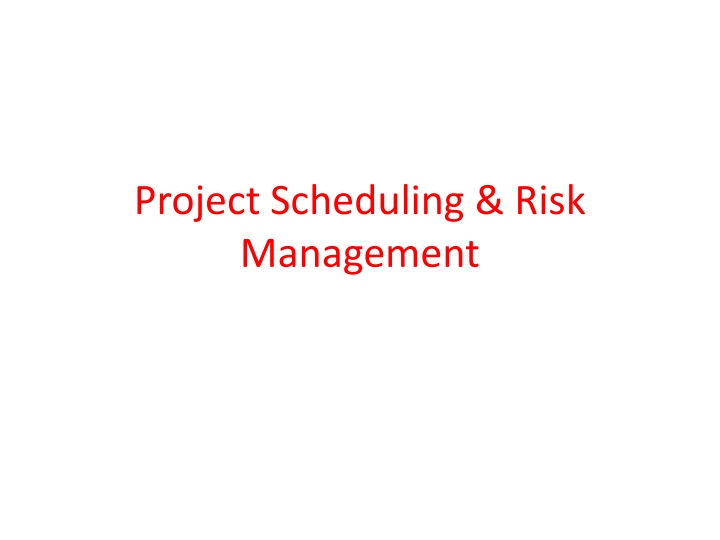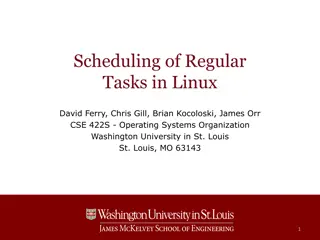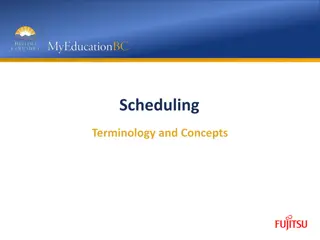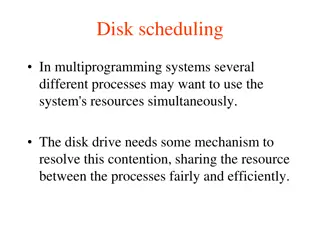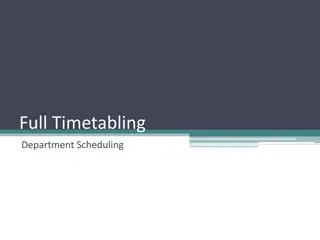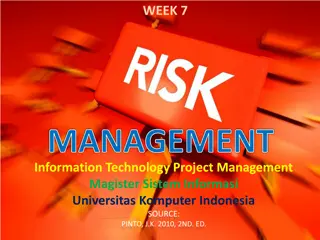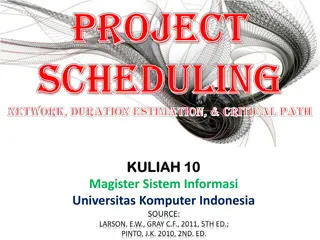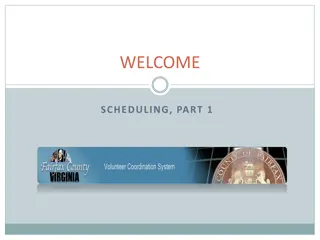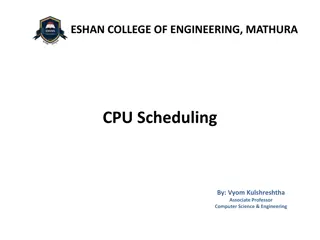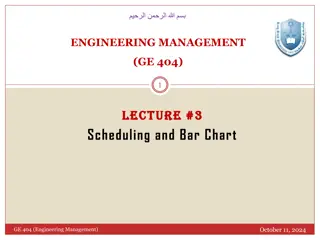Project Scheduling and Risk Management
In project scheduling, managers estimate time and resources, arrange activities in sequences, update schedules continually, and address typical development problems. Defining task sets is crucial for completing software projects effectively. Various project types like concept development, new application development, application upgradation, maintenance, and reengineering serve different purposes.
Download Presentation

Please find below an Image/Link to download the presentation.
The content on the website is provided AS IS for your information and personal use only. It may not be sold, licensed, or shared on other websites without obtaining consent from the author.If you encounter any issues during the download, it is possible that the publisher has removed the file from their server.
You are allowed to download the files provided on this website for personal or commercial use, subject to the condition that they are used lawfully. All files are the property of their respective owners.
The content on the website is provided AS IS for your information and personal use only. It may not be sold, licensed, or shared on other websites without obtaining consent from the author.
E N D
Presentation Transcript
Project Scheduling & Risk Management
While scheduling the project - the manager has to estimate the time & - resources of the project All the activities in the project, - must be arranged in coherent sequence The schedule must be continually updated
Total work of project, is separated into various small activities Some activities may work in parallel Fig - Project scheduling process Assign People To Conduct Activities Create Activity Network & Bar Charts Identify Activities Identify Possible Dependencies Estimate Resources
Some of the typical problems in project development stage are - People may leave or remain absent - Hardware may get failed - Software resources may not be available Various resources required for the project are - Human efforts - Sufficient disk space on the server - Specialized hardware - Software technology - TA, required by the project staff
Defining A Task Set For The Software Project
Definition of task set - The task set is a collection of - software engineering work tasks, milestones work products - That must be accomplished to complete particular project & Using the task sets, high quality software can be developed Number of task sets - will vary depending upon the type of the project.
Various types of projects are enlisted below. 1. Concept Development Project new business ideas or the applications based on new technologies, are to be developed. 2. New Application Development Project satisfies, specific customer s needs 3. Application Up Gradation Project existing software needs major change. 4. Application Maintenance Project correct, adapt or extend the existing software applications. 5. Reengineering projects legacy systems are built, partly or completely.
Various Factors, That Influence The Task Sets - Are - 1. Size Of Project 2. Project Development Staff 3. Number Of User Of That Project 4. Application Longetivity 5. Complexity Of Application 6. Performance Constraints 7. Use Of Technologies
Task Set Example Consider the project of the type Concept Development Project Various task sets in such projects are 1. Defining Scope defines, scope, goal or objectives of the software 2. Planning estimates, schedule, cost & people 3. Evaluation Of Technology Risks evaluates the risk associated with the technology used in the project 4. Concept Implementation includes the concept representation, as expected by the end user.
The task is a small unit of work The task network is a graphical representation with - Nodes corresponding to activities - Tasks/activities are linked if there is a dependency between them Task network for the product development is as shown below -
In software project scheduling, the timeline chart is created It is Used to emphasize scope of individual tasks Set of tasks are given as input to the timeline chart
In the timeline chart 1. All the tasks are listed at the leftmost column 2. The horizontal bars indicate the time required by the corresponding task 3. Multiple horizontal bars, at the same time indicates concurrent tasks 4. Diamonds indicates milestones.
Timeline Charts Tasks Week 1 Week 4 Week 3 Week n Week 2 Task 1 Task 2 Task 3 Task 4 Task 5 Task 6 Task 7 Task 8 Task 9 Task 10 Task 11 Task 12
After generation of time line charts, The project tables are prepared. In project table, - all the tasks are listed - along with actual start & end dates - & related information
Project table tasks Planned start Actual start Planned end Actual end Effort assignment Requirement analysis Sachin, mahendra Architectural design Procedural design Ravindra, suresh . . . . . . . . . . . . . . . . . . Customer training
Project manager decides & track the schedule Various ways of tracking the project schedule - Conduct periodic meetings - Evaluate results of all the project reviews - Compare actual start date & scheduled start date of each of the project task - Determine & achieve the milestones - Meet informally the software practitioners - Assess the progress of the project - quantitatively
EVA is a technique of performing quantitative analysis of the software project Provides a common value scale for every task of software project EVA acts as a measure for software project progress Quantitative analysis is EVA indicates - the percentage of the project, completed.
Risk Management Software risks
Risk - pat actions & - It may causes heavy losses An uncertainty that may occur in the choices Due to Risk Management - process of making decisions - based on an evaluation of the factors - that threats to the business Various activities, carried out for risk management are - Risk identification - Risk projection - Risk refinement - Risk mitigation, monitoring & management
Software Risks There are two characteristics of the risks 1. The risk may or may not happen - It shows the uncertainty of the risks 2. When risk occur, - unwanted consequences or losses will occur
Types Of Risks Project Risk affect budget, schedule, staffing, resources & requirements When project risks become severe, then the total cost of project gets increased Technical Risk - - affects quality & timelines of the project - If technical risks become reality, - then design implementation, interface, & maintenance problems get created. Business Risk when feasibility of software product is in suspect, then business risks occur - market risk, strategic risk, sales risk, management risk, budget risk, verification
Predictable risks Unpredictable risks
Reactive Vs Proactive Risk Strategies
Reactive Risk Strategies When project gets into trouble, then corrective actions are taken But when such risks cant be managed & new risks come one after another, The software team rapidly corrects the problems. These activities are called as firefighting activities
Resource are utilized to manage such risks & if, still the risk don t get managed, then project is in danger In this strategy, no preventive care is taken about the risks. They are handled, only when they occur This is an older approach of risk management
Proactive Risk Strategies Begin, before the technical activity, By considering the probable risk In this strategy, - Potential risks are identified first - Then their probability & impact is analyzed - Such risks are then specified according to their priorities - Finally, a software team prepares a plan for managing these risks
Objective of this strategy is to avoid the risks - (prevention is better than cure) If risk occurs, then a plan is prepared to handle the risk This is an intelligent strategy for risk management & now a days is used by many IT companies..
Risk Identification 1. Risk components & drivers 2. How to assess overall project risk?
Risk Projection 1. Building risk table 2. Assessing risk impact
Risk identification is done by project manager, by using following steps Step 1. Preparation of list item check list Risk items can be identified using following known & predictable components Product Size risk items based on overall size of software project, are identified Business Impact risk items related to marketplace or management can be predicted Customer Characteristics risks associated with customer-developer communication can be identified
Process Definition risk items, related with the processes, used, while developing the software Development Environment risks associated with the technology & tool being used for developing the product Risks associated with - Staff Size & Experience Technology To Be Built complexity of the system should understood & related risk items needs to be identified.
Step 2. creating risk components & drivers list - The set of risk components & drivers list is prepared - Along with their probability of occurrence - then their impact on the project can ba analyzed Let s understand which are the risk components & drivers
Risk Components & Drivers Types of risk components Performance risk Cost risk support risk Schedule risk -
How to assess overall project risk? Prepare a set of questions That can be answered by project managers To assess overall project risk These questions can be Will the project get proper support by the customer? Are the end users committed to the software, that has been produced? Is there a clear understanding of requirements? Is there an active involvement of customer, in requirement definition? Is the project scope stable?
Are there team members the required skills? Are project requirement stable?
